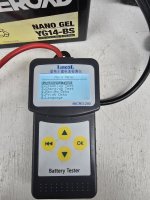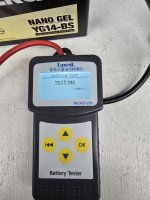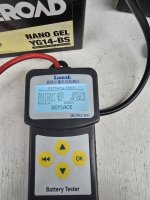Did it come with instructions? Put a pic of it up, someone may have the exact same unit.
You're voltage readings are ok, a little low perhaps if you're using an AGM battery, but still ok. There should be a battery test function, you just connect the battery (don't try to start it) then select from the menus what sort of battery you have (Wet, GEL, AGM etc) then set what you want to test, (there will be lots of different tests you can do, you want CCA. Once you've set it to test CCA you then need to tell it at what level, this is the CCA of the battery when new, I don't know your battery so can't be specific, but probably in the range of 250cca - 280cca would suffice. Once you have the parameters you want to test set, go ahead & it will do it's thing.
It should tell you state of battery health (as a percentage) it's voltage, it's internal resistance (higher is bad) and whether to replace, charge it or it's a good battery.
Oh forgot to mention, selecting the correct 'Type' of battery at the beginning is very important to getting correct results on the battery you're testing. If you test an AGM battery using Wet battery criteria you'll get a false set of data at the end, usually looks better than it is.







